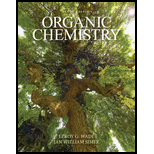
(a)
To determine: A mechanism for the given reaction.
Interpretation: A mechanism for the given reaction is to be calculated.
Concept introduction: The
(b)
To determine: The structure of rate limiting transition state.
Interpretation: The structure of rate limiting transition state is to be drawn.
Concept introduction: The chemical reaction which proceeds through the formation of radicals is known as chain reaction. It involves three steps, initiation, propagation and termination. Generally, the initiation step occurs in the presence of light. The quantum yield of chain reactions is very high.
(c)
To determine: The intermediate that closely resembles to rate limiting transition state.
Interpretation: The intermediate that closely resembles to rate limiting transition state is to be predicted.
Concept introduction: According to Hammond’s postulate, the structure of transition state resembles to the structure of compound that has energy near to it.
(d)
To determine: The explanation for high reactivity of bromine with cyclohexene than cyclohexane.
Interpretation: The explanation for high reactivity of bromine with cyclohexene than cyclohexane is to be stated.
Concept introduction: The chemical reaction which proceeds through the formation of radicals is known as chain reaction. It involves three steps, initiation, propagation and termination. Generally, the initiation step occurs in the presence of light. The quantum yield of chain reactions is very high.
Want to see the full answer?
Check out a sample textbook solution
Chapter 4 Solutions
Organic Chemistry (9th Edition)
- helparrow_forwardThe temperature on a sample of pure X held at 1.25 atm and -54. °C is increased until the sample boils. The temperature is then held constant and the pressure is decreased by 0.42 atm. On the phase diagram below draw a path that shows this set of changes. pressure (atm) 2 0 0 200 400 temperature (K) Xarrow_forwardQUESTION: Answer Question 5: 'Calculating standard error of regression' STEP 1 by filling in all the empty green boxes *The values are all provided in the photo attached*arrow_forward
- pressure (atm) 3 The pressure on a sample of pure X held at 47. °C and 0.88 atm is increased until the sample condenses. The pressure is then held constant and the temperature is decreased by 82. °C. On the phase diagram below draw a path that shows this set of changes. 0 0 200 temperature (K) 400 аarrow_forwarder your payment details | bar xb Home | bartleby x + aleksogi/x/isl.exe/1o u-lgNskr7j8P3jH-1Qs_pBanHhviTCeeBZbufuBYT0Hz7m7D3ZcW81NC1d8Kzb4srFik1OUFhKMUXzhGpw7k1 O States of Matter Sketching a described thermodynamic change on a phase diagram 0/5 The pressure on a sample of pure X held at 47. °C and 0.88 atm is increased until the sample condenses. The pressure is then held constant and the temperature is decreased by 82. °C. On the phase diagram below draw a path that shows this set of changes. pressure (atm) 1 3- 0- 0 200 Explanation Check temperature (K) 400 X Q Search L G 2025 McGraw Hill LLC. All Rights Reserved Terms of Use Privacy Cearrow_forward5.arrow_forward
- 6.arrow_forward0/5 alekscgi/x/sl.exe/1o_u-IgNglkr7j8P3jH-IQs_pBaHhvlTCeeBZbufuBYTi0Hz7m7D3ZcSLEFovsXaorzoFtUs | AbtAURtkqzol 1HRAS286, O States of Matter Sketching a described thermodynamic change on a phase diagram The pressure on a sample of pure X held at 47. °C and 0.88 atm is increased until the sample condenses. The pressure is then held constant and the temperature is decreased by 82. °C. On the phase diagram below draw a path that shows this set of changes. 3 pressure (atm) + 0- 0 5+ 200 temperature (K) 400 Explanation Check X 0+ F3 F4 F5 F6 F7 S 2025 McGraw Hill LLC All Rights Reserved. Terms of Use Privacy Center Accessibility Q Search LUCR + F8 F9 F10 F11 F12 * % & ( 5 6 7 8 9 Y'S Dele Insert PrtSc + Backsarrow_forward5.arrow_forward
